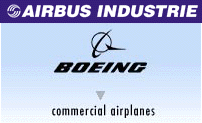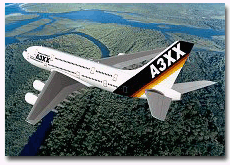The battle over bigger and better: The Airbus A3XX versus Boeing's B747X

•Airbus A3XX
•Bigger, More Economical Aircraft
•The Boeing 747X
•Deregulation is Key Factor

In recent years, a major feature of international air shows has been the jousting between Airbus Industrie and Boeing, over their respective commercial aircraft programs. This year's Farnborough seems set for a vintage occasion that was foreshadowed at the Financial Times World Aerospace and Air Transport Conference, in which speakers for the respective companies gave excellent, robust presentations covering the A3XX and B747X respectively. The following respects alphabetical precedence, rather than suggestion of other merits!
Airbus A3XX

Adam Brown VP, Market Forecasts Airbus Industrie, relied heavily upon market data of present and future projections to plead his case for the large airplane. He began by stating that the explosion in air traffic has placed considerable strain on the infrastructure, with a current risk of stifling future growth. Neither the aircraft manufacturers nor the airlines are earning the consistent financial returns needed to support the continuing development of the business on a sustainable basis.
Airbus believes that the time has come when a new element is needed to resolve this conflict and enable the airlines to grow profitably, despite the constrained environment in which they are obliged to operate. Apparently, airlines are telling Airbus that they now need a new generation of airliner, larger and more economical than anything flying today, offering high passenger comfort and exploiting all the technological advances that have emerged over the past 30 years, in order to offer a substantial reduction in operating costs per seat.
It is predicted that during the next 20 years, despite further advances in telecommunications and high-speed rail networks, passenger growth is expected to grow by just under five percent a year. Although this is lower growth than seen in the past, when compounded over 20 years annual rpk's will nearly triple from three to nearly eight trillion. That means that during the period the airlines will carry an average of five trillion rpk's, which is nearly four times the average of 1.3 trillion they carried during the past 30 years, when they ordered 1,300 Boeing 747s.
Airbus forecasts that in 20 years, the world's major airlines will offer 95% more daily departures than today, which actually represents a faster growth in frequencies than has been achieved during the past 25 years.
Bigger, More Economical Aircraft
Given the level of congestion and delays that are current today, given the severe environmental restraints on new runway development, given the lagging investment in new ATM systems, Brown suggests this represents a very considerable challenge. In turn, that means that demand will grow progressively for quite substantial numbers of new aircraft, larger and more economical than anything flying today. Starting from a total of just 48 747s in service today with more than 500 seats, a requirement for about 320 very large airplanes is envisaged in 10 years time and about 1,200 in 20 years time.
When the A3XX enters service in 2005, it will have just 33% more seats than the 747-400, which is in stark contrast to the 150% jump from the 707 to 747. Airbus says the A3XX will exploit all the advantages of technology, many of them pioneered on earlier Airbus designs, to bring about a reduction of around 20% in operating costs per seat.
Thanks to considerable input from 20 potential customers, the basic design is responsive to a variety of needs. As a result a family of different versions is evolving.
A3XX-100
The initial A3XX-100 will carry 555 passengers in tri-class configuration up to 7,800 nautical miles, enabling the aircraft to fly, non-stop, from London to virtually every major city on the surface of the earth with the exception of eastern Australia and New Zealand. A longer-range version will be available with an additional 350 nautical miles capability. As demand grows, it is intended to develop still longer range and higher capacity versions.
The A3XX-100R and –200 will offer respectively 600 nautical miles more range and 100 more tri-class seats and serve as the basis for the Freighter version, able to haul 150 tons of payload more than 5,600 nautical miles.
The airlines will have a choice of engines in the 65,000 to 75,000-lbs thrust class, either the Rolls Royce Trent 900 or The GT7200 from the alliance of GE and Pratt & Whitney. The A3XX-100 will burn 13% less fuel per seat and bring reductions of 17% in operating costs per seat and 16% in direct operating costs per seat.
Back to top
The Boeing 747X
The Boeing presentation was no less persuasive and it has to be admitted that Boeing is approaching this year's Farnborough Air Show in a particularly confident manner; perhaps there is an order in the offing?
Seddik Belyamani, Executive VP, Sales & Marketing Boeing Commercial Airplanes Group, began by a strident declaration that "Boeing builds a lot of new airplanes."
Since the last Farnborough show in 1998, Boeing has delivered 1,135 airplanes that are 70% of world total delivery. Three new Boeing models were certificated and entered service--the 717-200, 737-600 and the 757-300. The new 737-900 was due to roll out on the eve of the show and the 767-400ER is on a world tour prior to arriving at Farnborough.
In addition, Boeing has launched two new, long-range 777s and the Boeing Business Jet 2 (BBJ2), while developing the 21st Century family of derivatives of the 747.
Belyamani spoke of how the market has changed and discussed the airplane requirements for the next 20 years, with a focus on the larger airplane end of the market.
Deregulation is Key Factor
Government regulations, he says, have been critical in shaping the structure of the airline industry. Over the last 20 years the choices and expectations of passengers and airline customers have dramatically increased with the shift from regulated to de-regulated domestic and regional markets.
Before deregulation, airlines favored larger airplanes with low seat mile costs on denser routes. With deregulation, airlines in the US began to choose when, where and how often to fly. Manufacturers began responding with more fuel-efficient aircraft and more versatile aircraft, with more choices in capacity and range.
Available destinations and frequencies dramatically increased and both continued to rise in the years that followed. After deregulation airlines created sophisticated hubs to respond to passenger demand for schedule flexibility. Smaller airplanes became more prevalent. Deregulation in the U.S domestic market led to international liberalization. This had the biggest effect on the North Atlantic. Large, low seat mile aircraft dominated this market. With liberalization airlines, previously limited to domestic services, began to offer more non-stop flights to Europe from their US hubs. Travelers chose to fly these direct routes to Europe rather than indirect connecting flights. Liberalization has led to fragmentation, a very positive trend in the industry.
Indications of fragmentation are also appearing in Asia. The governments are moving to open skies. The U.S. has now signed such agreements with Brunei, Malaysia, New Zealand, Singapore, S Korea, Taiwan and Thailand. In 1998 US/Japan bilateral opened up services to new cities and new carriers. Major US airlines have now introduced new non-stop services to Japan.
Importantly, airlines now have the vehicle to fragment the market, including the longer-range versions of the 777. As market fragment, the historic trunk routes will lose share to faster, growing non-stop services.
Based on projected air traffic growth rates, the world's airlines will need 22,300 aircraft over the next 20 years. More than 4,300 will replace older aircraft and more than 18,000 will be required to accommodate the growth in world aircraft. All these aircraft are worth about $1.5 trillion. The interesting concept is that almost 80% of this amount is represented by single aisle and intermediate twin aisle aircraft.
The biggest change will be in the regional segment, which is projected to grow from seven percent to 15%. The next most significant market is in the intermediate-size, twin-aisle aircraft, which will increase from 19 to 22% of the fleet. At the same time, the 747 and larger airplanes will decline from seven percent to six percent of the world fleet over the next 20 years.
As the world continues to open its skies, airlines can be expected to offer more non-stop flights between more cities. Boeing's projection for the market for passenger airplanes larger than the 747-400 is only 336 airplanes to 2019. When freighters are added, the total number is approximately 500 aircraft.
In liberalized markets, stresses Belyamani, airlines have chosen to add new non-stop flights to new destinations; they are not looking for dramatically increased aircraft size to existing destinations. More flights not bigger aircraft. Of course, some dense routes will require a larger aircraft.
747 Derivatives
To meet this need Boeing's strategy is to pursue 747 derivatives, instead of an all-new large airplane. This is considered to be the most economical, lowest risk solution relative to the small size of the market.
The 747X stretch offers more capacity, seating between 504 and 522 passengers, in a standard tri-class configuration. The aircraft offers good range, 7,600 to 7,800 nautical miles, at a cruise speed of Mach 0.86.
Cargo capability is also important. The 747X has more than 1,000 cu. ft. of additional space in its lower hold than the A3XX-100. Assuming a full passenger load, the revenue cargo space of the 747X will be 55 to 65% higher than the A3XX-100. The 747X will also have an upgraded flight deck and systems, and feature a significantly enlarged and modified wing. The interior will be based on the 777 cabin configuration, with much more overhead carry on bag stowage.
Boeing believes that the 747X will offer superior value with 9% lower trip costs than the A3XX-100 and one to three percent lower seat mile costs. It offers commonality with existing fleet and will have the same crew type rating as the 747-400, this reduces training costs and enhances flexibility in scheduling. Commonality also makes the aircraft more compatible with existing infrastructure.
Now it is up to the potential airline customers to make their choice, while acknowledging that the only real difference between Airbus and Boeing is their perception of the size of the market for the "Super Jumbo."
Edited by David Robb
Managing Editor, Aerospace Online
